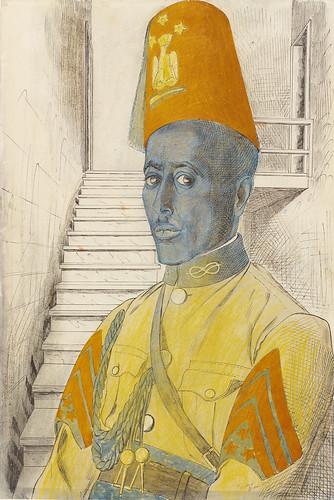I thoroughly enjoyed my trip to DPG. Edward Bawden was an artist who lived in Great Bardfield, known primarily for his postwar printmaking.
The exhibition started with commissions he had worked for film posters - The Titchfield Thunderbolt, and Hue and Cry - when he was newly graduated. Also copperplate etchings - he was interested in the combination of image and script. I very much liked his coloured linocut prints - often 5-6 colours. I'm thinking about how I can start to do multi-coloured linocuts. Maybe I should start with bi or tri-coloured first! Later on in the exhibition, some of his architectural prints showed 6 colours, but when I visually separated the layers, it was possible to work out what order they had been printed in.
Bawden was a war artist. Up until then, his work had focussed on the environment around him (many of his works were drawn from life, in a radius of places accessible when cycling from Great Bardfield), often of landscape, with tiny people depicted within it. This was because at art school, he had been denigrated for being poor at the human figure to the extent that he had avoided life class. Yet once he was sent to theatres of war, he spent a lot of time creating portraits of all sorts of forces personnel, from many different races, regiments, ranks etc. Often watercolour, the tonal values and colours (shades of sludge, and the desert) did not appeal to me, but the representation of people did.
Scium Basci Tesfalidet Ghidai: Polizia Africana Italiana, Asmara, Eritrea. A sergeant in the Police Force formed by the Italians, 1940-44. Top. Brighton Pier, linocut, 1958.
I liked the variation in scale. Bawden worked some pieces in miniature, and some quite large scale. The image of Lindsell Church was too big to go through his press, so there was a video of him inking the plate, laying the paper on, and standing on it! This was on the audio/visual device (£3 - worth having). Dark and dramatic - I'll make a detour next time I'm biking through Lindsell to see how the site compares 50 years later.
I also enjoyed looking at some of the ephemera - in a case there was a sheet of blotting paper, with his doodles on it, along with children' books he had illustrated. There is something about his art that is very accessible, and of its age, that makes it very appealing. The cohort of visitors indicated to me that the exhibition was a trip down memory lane for many of them. When working with his children, he used the name De Ward Nedwab. That would make my name Yhtac Traggat Cam!
On my way home, I met a man at the bus stop, who managed to get right up my nose. We were discussing the Bawden show. He belittled Bawden for being a lesser artist, who was primarily a designer (I look at all sorts of artists, seeking value in what their art says, not considering whether they are lesser, or greater!). I'm not interested in the artist/designer argument - was he belittling Bawden because he made a good living from his art? The man said he thought Bawden was less able than Ravilious, (but in my opinion, more diverse in his use of materials), and that Bawden's work showed influence from John Piper and Graham Sutherland but never had their power from dereliction and devastation. All artists show influence from their peers and others they admire! This man also grumbled about the entry price (£16.50 full price, £7 concession). I thought it was a bargain! I pointed out that many of the images were from private collections, and this meant I could not see them unless they were exhibited this way. I wondered how many of the 'private collection' pieces were from the Bawden family? I really enjoyed the exhibition, although I admit I am biased because I often recognised the views depicted, as I ride my bike in the Great Bardfield area, and I like linoprint.
I found Bawden's use of print inspiring, and I'm inclined to explore this more in my own artwork.















